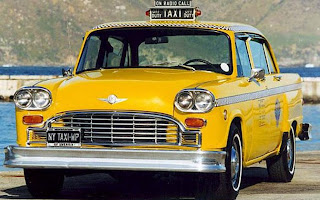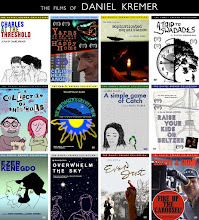
(The Other 42nd Street)
This will be an epic post because the personal ideologies that led to it have been a long time coming in terms of the actual formal expression of them. This is a passionate, deeply considered topic for me.
A CHANCE ENCOUNTER
I was inspired to write this entry after riding my bicycle on 91st Street, in between First and Second Avenues. While speeding down the block on my old green Schwinn, I slammed on my brakes in one sudden, jarring reflex, thankful that there were no vehicles directly behind me. Before my eyes, which were suddenly glazed in absolute awe and wonderment, I observed an original Checker taxicab, one of the old "big-boy models" with the exquisitely hulking antique body and, of course, the yellow and checker design which were featured so prominently in the Manhattan movies of the 50's, 60's and 70's. You know, the taxis like Travis Bickle drove in Taxi Driver. Immediately, I was taken back in time in my own mind to another New York or, as I consider it, Manhattan before the Times Square area morphed into an ugly techno-wonderland with a constant stream of media images in every nook and cranny...what I like to call The Other Disneyland. Oh yes, and when 42nd Street was the super seedy porno-theater retreat-street...and not the tourist attraction that it is currently.
Just the day before, I was walking with a friend on the Upper West Side. This walk ultimately became a "movie tour" of the West Side as we passed by The Dakota (the deluxe, legendary New York apartment building with the open courtyard where Rosemary's Baby was shot and where John Lennon was gunned down in 1980), the apartment building "penthouse" where Sylvia Miles lived, with poodle, when she invited Jon Voight up for the misbegotten trick in Midnight Cowboy, and what was once (but is decidedly no longer) Needle Park at West 72nd and Broadway, featured in 1971's The Panic in Needle Park as the hang-out for the heroin addict characters.
THE THEN AND THE NOW
About a year ago, my brother and I spoke on the phone. Then residing in Brooklyn, he informed me that he had recently watched Scorsese's Mean Streets, and deeply and openly lamented that the New York of now could never compare to the New York of that film.
I believe firmly that this rapid evolution in the image of Manhattan began when the original Checker Cabs were expired in 1983. Confessedly, I have the most enormous love of the New York films of the late 60's and early 70's, certainly more than any other time and place on celluloid. New York City had the grit, the edge, the often seaminess and the indescribable flavor that it sadly lacks now in the age of gentrification. This entry intends to explore the films made at the outset of the evolution (circa 1982 and 1983) and pay tribute to the films before that age that captured what is in my mind the true Manhattan.

THE PLANTED SEEDS OF THE CHANGE
To begin, I wish to name a few key films to be shot in Manhattan during the evolutionary period of 1982 and 1983: Martin Scorsese's The King of Comedy (1983), Susan Seidelman's Smithereens (1982), Bette Gordon's Variety (1983), Henry Jaglom's Can She Bake a Cherry Pie? (1983), Yvonne Rainer's The Man Who Envied Women (1985), Sidney Lumet's Prince of the City (1981) and Lizzie Borden's Born in Flames (1983). Each of these films represents the ethos of Manhattan as a movie location on a geographic basis. In The King of Comedy, there is a sequence in which Robert De Niro and Sandra Bernhard are stomping down Broadway approaching a Times Square astonishingly without MTV or CNN news-feeds and Disney Channel image-streams...and you can see the occasional Checker taxicab pass by on screen right. In Smithereens, characters frequent now-nonexistent bars and punk-band clubs in SoHo, and a SoHo itself that no longer exists in the wake of the Neo-Hipster post-X generation. Take a walk through it as it exists now, then watch Smithereens and maybe compare it to the SoHo of Andrew Bujalski's Mutual Appreciation (2005). In Variety, the lead character works in the ticket booth of a porn-theater on 42nd Street. I am not, nor have I ever been, a frequenter of these establishments, but where can you see a single theater of this kind on the 42nd Street of today? In Can She Bake a Cherry Pie?, Cafe Central on 79th Street near Columbus is featured prominently as a hang-out for the post-30s singles crowd and Checker cabs are still on the radar. In The Man Who Envied Women, shot 1982-1984, the Upper West Side and Central Park West is the specialized area and, surprise surprise, Central Park West seemed to be the area that has changed the least. Prince of the City, which features many New York locations throughout its 167 minutes, peaks into the netherworld of the Bronx ghettos and the Washington Heights of yore...and into the buildings of ill-repute before they even became known as crackhouses. In Born in Flames, released in 1983 and shot over a period of almost two years, a fictional New York underground world of a quasi-future (i.e. the future as rendered by low-budget filmmaking) makes one long for the self-proclaimed glorious past. Even the bigger budgeted Soylent Green (1973), set in the year 2022, makes one hunger for that "something lost" in nearly an identical way. In a sense, this is a deep feeling of nostalgia for something that, on the surface to most people, is the Before to a current After...like the fat-cells of a jelly-donut that regret that they will never get the opportunity to join the legions of other fat cells on an obese man religiously intent on shedding copious pounds.
In my belief, the post-O'Hara Manhattan (i.e. I am referring to writer Frank O'Hara's poetic conception of 1950's New York) as documented in cinema can be divided distinctly into eras without feeling arbitrary, because each of these eras has an undoubtedly different feel when viewing the films respective to them. First, there is the Neo-Grey-Flannel-Suit Era (signified by films like The Apartment, Two for the Seesaw, The Pawnbroker, Sunday in New York and How to Succeed in Business Without Really Trying), then the Warhol Era (these are not strictly Warhol films, but simply movies, either indie/underground or mainstream, made during and right after Warhol started his experiments in filmmaking in the late 60's, signified by films like Midnight Cowboy, with its "wild hippy party scene," Greetings!, Hi, Mom!, Taking Off and Coogan's Bluff), followed by the Urban-Junkie/Loner Era which conincides with the Literary Jetset Era (signified by films like Born to Win, The Panic in Needle Park, Believe in Me, Maidstone, Such Good Friends and Ice). Following these first three, there lies the Summer-of-Sam Era, a time marked by the paranoia and pressures of a struggling late 70's economy (signified by films like Saturday Night Fever, Girl Friends, Annie Hall, Nunzio and Rich Kids). Beginning in the 80's, the arrival of the No Wave Movement saw the complementary arrival of the New York punk film (examples being works by filmmakers Amos Poe, Nick Zedd, Jim Jarmusch, Vivienne Dick and James Nares). The No Wave Era also will point to films like Mr. Mike's Mondo Video, Koyaanisqatsi (strictly in its use of New York), They All Laughed, Dear Mr. Wonderful, Street Smart (featuring a depiction of the last remnants of the old Times Square) and Lightning Over Water. Other films released by the company Pacific Arts around the time were also revealing of the No Wave's influence on the New York films of the time. Following the 1983 Evolution came the arrival of the Yuppie Film. Look no further for films of this era than The Secret of My Success, Big and Baby Boom. The Manhattan Financial District underwent a Renaissance of sorts in American film as Yuppiedom prevailed in mainstream cinema, particularly New York mainstream cinema of the late 80's. The post-1992 New York films are just one mass blur as the evolution became visible to the naked eye for the first time.

A TRIBUTE
To pay tribute to the "golden-age" films, I am going to begin with an unlikely film, and one that is vital to mention. Milton Moses Ginsberg's Coming Apart (1969), starring Rip Torn, Viveca Lindfors and Sally Kirkland, is a reflexive hidden-camera metadrama shot in a single Manhattan studio apartment. The film is a mostly one-camera-angle shooting directly into a mirror reflecting a window peering high over Manhattan's West Side. We never leave this apartment throughout the length of this two-hour film. Not once! Yet, you get a feeling of a different New York, a much different New York, lying outside the doors of this single location. You feel it without seeing it. That is what my point is. It is not so much a visual thing (although the "visual thing" is the major component of the evolutionary adjustments I mention before), but a feeling of what it was and what it meant for people to live in New York before the technocracy took hold of the city's infrastructure. It lost some of its intrinsic character as time progressed. I still love living in New York. I cannot imagine living anywhere other than a city, and this is the king of cities, but I wished I lived in the New York of then as opposed to now...so I could shoot it and make movies in it.
There are other films worthy of mention. William Friedkin's The Night They Raided Minsky's, shot in early 1967 and released in late 1968, recreated the Lower East Side of 1925 without losing its place in New York filmmaking history's treatment of the late 60's. I could watch the location work in this film for days without growing bored. Claudia Weill's Girl Friends, released in 1978, was a then much-touted, acclaimed indie film that has a singular way of possessing a feeling of "lost New York" when watching it today on my old VHS. The look, feeling and ethos of the Greenwich Village in Brian De Palma's Greetings! (1968) and the Midtown in his Hi, Mom! (1971) are, once again, gone today. It goes without saying that the Manhattan in Midnight Cowboy is nowhere to be found. The picaresque locations in the opening montage of Dog Day Afternoon, the beautiful East Side "rooftop gardens" in Henry Jaglom's A Safe Place (1971), the Central Park of Bill Greaves' Symbiopsychotaxiplasm (1968), the then less-developed Chelsea area of Yvonne Rainer's Kristina Talking Pictures (1976), the Needle Park of Jerry Schatzberg's The Panic in Needle Park (Needle Park is now known, in the post-Giuliani era, as Verdi Square), the Times Square of Ivan Passer's Born To Win (1971)...all gone gone gone.
IN CONCLUSION
So what does it all mean now? How can we juxtapose it to what it meant then? How can we do it as filmmakers and film watchers? How can people like my brother reconcile the feelings he had for the New York of Mean Streets to the only New York we can walk through today? And, ultimately, what is the value of a place and the character of location, and what role does it play in our intake, digestion and renewing appetite for films that seek to capture time, place, atmosphere, the common feeling of its teeming people, for posterity? The pre-evolutionary, pre-gentrification places were seedy...but for filmmakers, this New York was the land of the seeds. Ideas sprouted from the harsh realities of urban life...from the personality of the city itself. Now, all we have is this little word, "retrospect".


